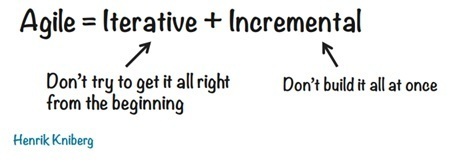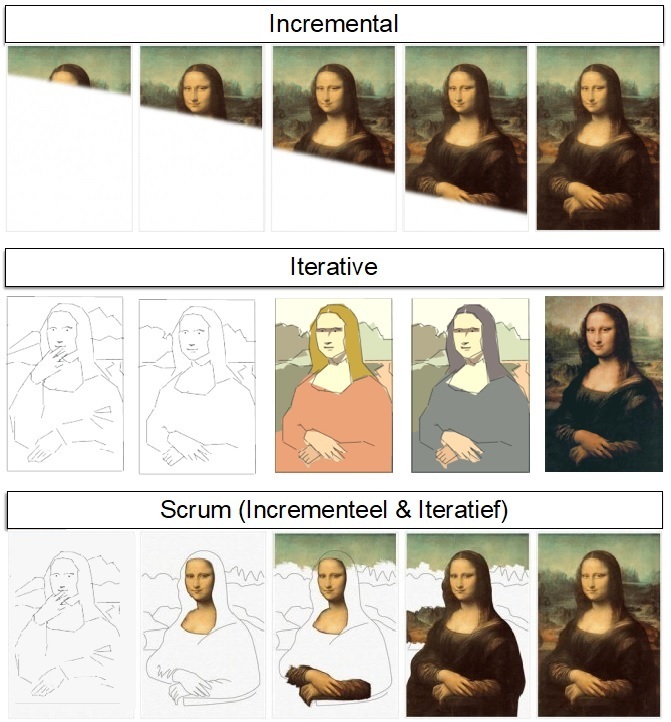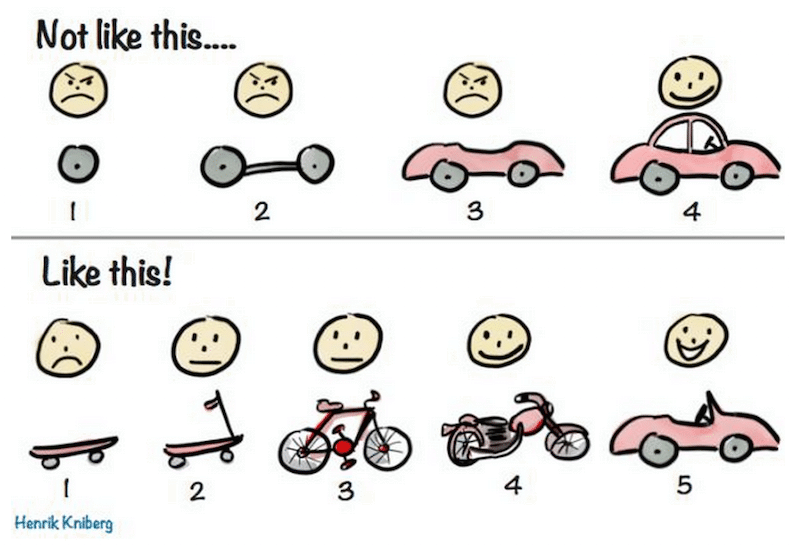Agile Manifesto | Principle 1

Principle 1
Our highest priority is to satisfy the customer through early and continuous delivery of valuable solutions*
In waterfall project management we envision a final solution and make a grand plan on how to accomplish all its features. We start with specifying the requirements for getting from start to finish, followed by the design phase, implementation phase, testing phase, deployment phase and finally, maintenance phase. Different parts of the solution are usually delivered in silos within the organisation and handed over to a different set of people when reaching the next phase. This approach bares the potential for wasted resources: First, a lot may change from start to finish, in terms of market situation, legal regulations or what the customer needs/ wants. The waterfall approach is not adept to quickly respond to these changes (Principle 2), resulting in implementations that may be outdated or no longer needed. Second, time & tacit knowledge maybe lost due to the many handovers waterfall project management entails. The lead time* may take several months to several years. The focus in waterfall project management is sticking to the plan.

In contrast, the focus of agile project management is continuous value delivery. This is achieved by an iterative (Principle 2) & incremental (Principle 3) approach. The main difference between iterative and an incremental life cycle is that an iterative process makes progress through continuous refinement while an incremental process makes progress through small increments.
The following picture trilogy demonstrates the difference between an incremental painting of Mona Lisa, an iterative one and a combined one. In the incremental approach, the Mona Lisa is painted step by step, as if put together by puzzle pieces, started off at an arbitrary corner. The iterative approach starts with an outline of Mona Lisa, and continuously refines the outline until the most important features – the hands and the face – have been worked out, after which colour is added. The combined approach is analogous to starting with the most relevant puzzle pieces (face & hands), after an outline was drafted.

Another example of delivering continuous value iteratively & incrementally is the following: Suppose your customers want a vehicle with wheels that bring them from A to B. Instead of envisioning a car from the start and putting together the different pieces (waterfall approach), we first build a skateboard, which is already a functional increment of value (Principle 3). Upon receiving frequent feedback from the customer after every iteration (Principle 4) we refine the vehicle in each step to finally arrive at the car. The skateboard is an example of what is called the Minimum Viable Product (MVP)* in agile project management.

The advantages of such an agile iterative & incremental approach of building a solution are not far to seek: Every iteration, the customer receives a functional piece of value that they may use already and have the chance to deliver feedback from a user’s perspective. Any kind of changes along the way – whether from customer side or external circumstances – can be responded to swiftly. Which turns us to Principle 2, stay tuned for next week 😊
Explore each principle & value with us
Introduction to the Agile Manifesto & Part 1 – The Agile Team: Skills & Culture
Principle 1: Our highest priority is to satisfy the customer through early and continuous delivery of valuable solutions*.
Principle 2: Welcome changing requirements, even late in development. Agile processes harness change for the customer's competitive advantage.
Principle 3: Deliver working solution* frequently, from a couple of weeks to a couple of months, with a preference to the shorter timescale.
Principle 4: Business people and team* must work together daily throughout the project.
Principle 5: Build projects around motivated individuals. Give them the environment and support they need, and trust them to get the job done.
Principle 6: The most efficient and effective method of conveying information to and within an agile team is real-time conversation.
Principle 7: Working solution* is the primary measure of progress.
Principle 8: Agile processes promote sustainable development. The sponsors, team*, and users should be able to maintain a constant pace indefinitely.
Principle 9: Continuous attention to technical excellence and good design enhances agility.
Principle 10: Simplicity – the art of maximizing the amount of work not done – is essential.
Principle 11: The best architectures, requirements, and designs emerge from self-organizing teams.
Principle 12: At regular intervals, the team reflects on how to become more effective, then tunes and adjusts its behavior accordingly.
Value 1: We value individuals and interactions over processes and tools.
Value 2: We value working solution* over comprehensive documentation.
Value 3: We value customer collaboration over contract negotiation.
Value 4: We value responding to change over following a plan.
*LEGEND:
Business Value: Business Value encompasses any deliverable, feature, or enhancement that directly contributes to customer satisfaction, employee well-being, or overall organizational success. It can encompass not only customer-facing elements but also internal enablers that improve efficiency and effectiveness within the organization.
Developers: has been exchanged by team to recognize that Agile Teams can encompass a diverse range of roles and functions beyond just software development
Iteration: An Iteration refers to a distinct phase or cycle within a development process, where a set of tasks or activities are completed in a defined timeframe. In Scrum methodology, an Iteration is known as a Sprint, typically lasting 2-4 weeks, during which a set of prioritized work items are completed.
Lead Time: Lead Time refers to the duration it takes for a task or project to move from the initial request or conception stage to its completion, including all necessary processes and steps.
MVP (Minimum Viable Product): The MVP is a basic, functional version of a product or service that includes essential features, allowing it to be deployed or released to gather early feedback from users or customers.
Software: has been replaced by solutions to account for the fact that Agility does not only apply to software development, but to any kind of value that a business offers to the customer.
It might also interest you!

Agile Manifesto | Principle 2 & 3

Agile Manifesto | Principle 4
